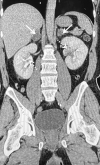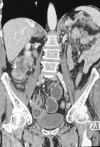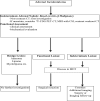Imaging incidental adrenal lesions
- PMID: 35543634
- PMCID: PMC9975514
- DOI: 10.1259/bjr.20220281
Imaging incidental adrenal lesions
Abstract
Incidental adrenal masses are among the most common incidental lesions detected on cross-sectional imaging. The majority are benign lesions, adenomas and myelolipomas being the most common. Simple cross-sectional imaging techniques using CT and MRI permit the characterization of over 80%, thereby requiring no further imaging. The remaining lesions are considered indeterminate. These lesions consist of benign and malignant lesions sharing imaging features. Further imaging and management of these indeterminate lesions should be guided by close collaboration between different specialists in an MDT setting. Advanced imaging options include dedicated adrenal scintigraphy, positron emission tomography CT, biopsy and surveillance. Biochemical and hormonal evaluation is also important to identify hyperfunctioning adrenal lesions. This review focuses on imaging features of benign and malignant adrenal masses used for characterization and suggests an imaging pathway for indeterminate adrenal masses.
Figures













Similar articles
-
The indeterminate adrenal lesion.Cancer Imaging. 2010 Mar 18;10(1):102-13. doi: 10.1102/1470-7330.2010.0012. Cancer Imaging. 2010. PMID: 20299300 Free PMC article. Review.
-
Imaging evaluation of the non-functioning indeterminate adrenal mass.Trends Endocrinol Metab. 2004 Aug;15(6):271-6. doi: 10.1016/j.tem.2004.06.012. Trends Endocrinol Metab. 2004. PMID: 15358280 Review.
-
The incidental indeterminate adrenal mass on CT (> 10 H) in patients without cancer: is further imaging necessary? Follow-up of 321 consecutive indeterminate adrenal masses.AJR Am J Roentgenol. 2007 Nov;189(5):1119-23. doi: 10.2214/AJR.07.2167. AJR Am J Roentgenol. 2007. PMID: 17954649
-
The indeterminate adrenal mass in patients with cancer.Cancer Imaging. 2007 Oct 1;7 Spec No A(Special issue A):S100-9. doi: 10.1102/1470-7330.2007.9017. Cancer Imaging. 2007. PMID: 17921094 Free PMC article. Review.
-
Radiologic evaluation of incidentally discovered adrenal masses.Am Fam Physician. 2010 Jun 1;81(11):1361-6. Am Fam Physician. 2010. PMID: 20521756 Review.
Cited by
-
Incidental imaging findings from head to toe: challenges and management: introductory editorial.Br J Radiol. 2023 Feb;96(1142):20239002. doi: 10.1259/bjr.20239002. Br J Radiol. 2023. PMID: 36692871 Free PMC article. No abstract available.
-
Quantitative PCCT imaging in differentiating adrenal adenomas from metastases: diagnostic performance and its clinical applications.Abdom Radiol (NY). 2025 May 21. doi: 10.1007/s00261-025-04987-9. Online ahead of print. Abdom Radiol (NY). 2025. PMID: 40397127
-
Adrenal Mass Evaluation: Suspicious Radiological Signs of Malignancy.Cancers (Basel). 2025 Feb 28;17(5):849. doi: 10.3390/cancers17050849. Cancers (Basel). 2025. PMID: 40075696 Free PMC article. Review.
References
Publication types
MeSH terms
LinkOut - more resources
Full Text Sources
Medical

